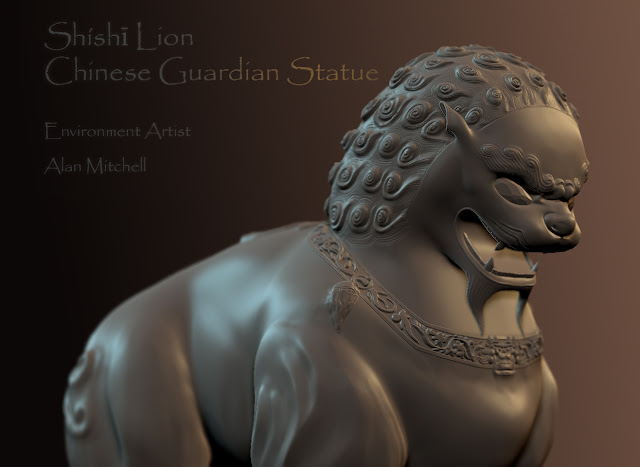Chinese guardian lions, known as Shishi which literally translates to "stone lion" it is also often incorrectly called "foo dogs". Traditionally the Shishi Lion stands in front of Imperial palaces, Imperial tombs, temples, and houses of the wealthy. It was often a sign of upper class citizens. These lions are always created in pairs, with the male with a open mouth resting his right paw upon the world sometimes having a geometric pattern. The female lion has a semi closed mouth restraining under its left paw a playful cub that is on its back. The pair keeps with the yin and yang principal China holds so dear. The Shishi Lions were originally believed to have powerful mythic protective benefits. The look of the Shishi lion changed drastically during its transportation along the silkroad. What I found really interesting was the Komainu or the Korean Dog was based off of the Chinese guardian statue. Eventually it spread to Japan where it became Kitsune a fox statue, which is offered to Inari shrines by worshippers, as part of the Buddhist culture. The reason I picked the Shishi Lions for my scene was because it was something that was distinct and allowed artistic license to it.
Friday, April 20, 2012
Thursday, April 19, 2012
Chinese Painting
I made this Chinese painting so I could experiment with the intentional brush stroke that defines Chinese art. I have always been fascinated by the horizontal orientation that screams eastern culture. I learned quite a bit about Chinese paintings through the process of making this digital painting. Through my research I learned that the red mark in the corner is calligraphy print of the artist’s name. Also there are normally a number of these printed marks on the painting indicating the people who have owned that specific piece of artwork, each person adding to the legacy of that painting. Poetry is often found on Chinese paintings, usually pertaining to the subject matter or sometimes the trials the artist had when making that specific piece of artwork. There is a larger value placed on words and how things are worded in Chinese culture.
The printed mark in the corner is my name Mitchell, Alan which is read from right to left, which was a little bit confusing. Eastern culture puts the family name first, followed by the individual’s name and it is read right to left traditionally. I learned one more thing from my research, the tree I used actually isn't a cherry blossom as I first thought, but it's actually a plum blossom tree.Saturday, April 14, 2012
Chinese Level Start
UDK - Chinese Level
UDK - Chinese Level
Unreal Viewport
Base Maps -Spec, Nom, Diff
Shishi Lion Body Maps - Spec, Nom, Diff
Shishi Lion Head Maps - Spec, Nom, Diff
Crosshatch Brickwork Maps - Spec, Nom, Diff
Ice Maps - Spec, Nom, Diff
Snow Maps - Spec, Nom, Diff

Shishi Lion Sculpt
Shishi Lion Body Maps - Spec, Nom, Diff
Shishi Lion Head Maps - Spec, Nom, Diff
Crosshatch Brickwork Maps - Spec, Nom, Diff
Ice Maps - Spec, Nom, Diff
Snow Maps - Spec, Nom, Diff

Shishi Lion Sculpt
Skull Sculpt

Coin Maps - Spec, Nom, Diff
Gold Coin Maps - Spec, Nom, Diff
Gold used in this article Link
Medkit
UDK Vertex Blending
Skull Maps - Spec, Nom, Diff
Coin Maps - Spec, Nom, Diff
Gold Coin Maps - Spec, Nom, Diff
Gold used in this article Link
Medkit
Medkit Maps - Spec, Nom, Diff
Da Vinci - Digital Paint
Sherlock Holmes
2004 - scratchboard
 |
| one of my favorite pieces |
Subscribe to:
Posts (Atom)






















